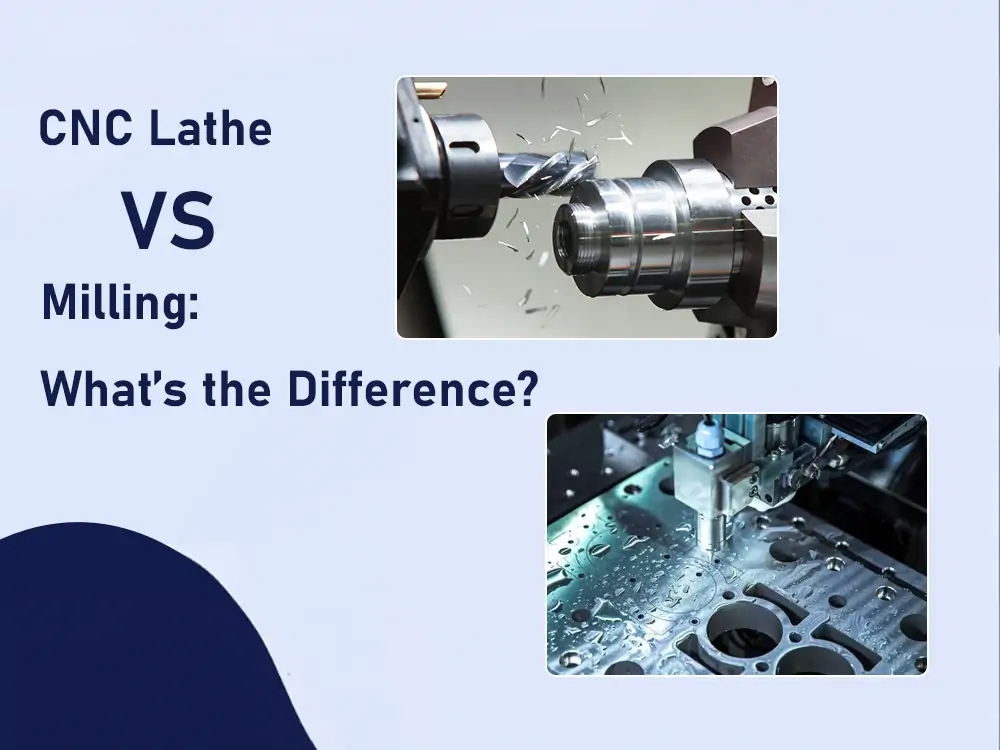Most CNC machines are computer-controlled and can create precise and accurate components. As a newbie, it may be challenging to understand the operations of these machines and easily choose one over the other. While their operations overlap, CNC mills and CNC lathes have their unique strength and weaknesses.
The question ‘Is a CNC mill better than a CNC lathe?’ remains thc same in precision machining. CNC mills may be better than CNC lathes in certain instances. In other applications, CNC lathes have an edge. This article will explore the distinct capabilities of a CNC mill vs a CNC lathe. It will explain their differences and situations when a particular CNC machine is better than the other.
What is a CNC Mill
A CNC mill is an advanced machine you can use to shape, drill, and cut different types of materials including metal, plastic, and wood. The machine can control various tools from face and end mills to taps and reamers. Computer programs and codes tell the tools how and where to move. When using a CNC mill, the workpiece remains stationary while the cutting tool rotates at a high speed. This action removes excess material gradually to create high-quality final parts.
Furthermore, CNC mills are classified based on the number of axes they can move simultaneously. The 3-axis CNC mill moves along linear axes X, Y, and Z to machine simple geometries and features. The more sophisticated ones have additional two rotational axes A and B which allow you to work on highly complex designs. CNC mills produce accurate and precise parts. This machine can achieve tolerances as tight as +/- 0.005 inches. However, it requires a high level of maintenance to function optimally.
What is a CNC Lathe
A CNC lathe is a precision machine you can use for turning operations. This machine is made up of the spindle, chuck, control panel, and bed as the main components. For it to work, you mount the workpiece on the spindle which rotates over the turning tools to make useful components. You then monitor the machine in real-time while it is working and make adjustments as needed. Note that this machine is not limited to turning operations. You can also use it for grooving, drilling, facing, and boring applications.
Based on their orientation, CNC lathes come in either the horizontal or vertical type. With horizontal CNC lathes, you mount the workpiece horizontally as the cutting tool moves across it. This feature makes this lathe type suitable for machining longer workpieces at a high speed. However, the workpiece is placed on a vertical axis in vertical CNC lathes. This implies that you work in an up-and-down motion. Vertical CNC lathes are designed to produce larger and heavier workpieces.
Is A CNC Mill Better Than A CNC Lathe
Deciding if a CNC mill is better than a CNC lathe can be tricky. There is no straightforward answer to this question as each machine has its unique advantages and shortcomings. Choosing the best between both depends on the shape of the workpiece, the specific machining operation required, and the applications.
CNC mills may be better when machining flat or irregularly shaped parts that require multiple and intricate features. When working with cylindrical workpieces, CNC lathes are the better option. These machines are optimized for rounded components and those with axially symmetrical shapes.
CNC Mill Vs CNC Lathe: A Detailed Comparison
To understand better, let’s discuss the differences between a CNC mill and a CNC lathe
- Primary Function
The major difference between CNC mills and lathes is their capabilities and how they function. CNC milling machines are used for milling operations. They work by cutting and shaping solid materials into intricate geometries. On the other hand, you use CNC lathes for turning processes mainly for cutting and finishing cylindrical workpieces.
- Workpiece and Tool Movement
The orientation of the workpiece also differs. In CNC mills, you fix the workpiece on the table or bed. The workpiece remains stationary and does not move independently. However, the cutting tools are attached to a spindle that moves both vertically and horizontally for a cutting action. When using CNC lathes, the reverse is the case. The tool movement is limited and is mostly stationary. Rather, the workpiece that is attached to a chuck rotates at a high speed around a central axis. The tools cut away materials as the workpiece spins.
- Tooling
The type of cutting tools and how they function is another way CNC mills and CNC lathes differ. CNC milling machines are compatible with different types of multi-point tools including drills, end bits, face bits, taps, and fly cutters. The tool paths are controlled by the machine’s software and it is possible to change tools automatically and handle multiple operations. On the other hand, the tools in CNC lathes are single-point ones. They can perform a cutting action in one pass. Examples of CNC lathe-cutting tools are turning boring, parting, and grooving tools.
- Programming Complexity
You can also differentiate between CNC mills and CNC lathes based on the level of programming complexity. The codes used to guide the machine and tools’ movement are more complex. This is because milling machines can move along 5 axes or more and you need to write precise codes to control these movements and functions. Conversely, CNC lathes need simplified programming because they operate with fewer axes. You use these machines for more specific and straightforward operations.
- Types of Parts Produced
The type and shape of the workpiece CNC mills and CNC lathes can handle are also different. You can use milling machines for 3D contoured parts that have detailed features and multiple designs. Furthermore, these machines are ideal for parts that are flat and irregularly shaped. On the other hand, CNC lathes are best for cylindrical and rounded workpieces. They can produce parts with simple to moderate complexity accurately and precisely.
- Cost
Cost and total investment are other differentiating factors. These include purchase and set-up expenses, maintenance costs, and operational costs. CNC mills are more expensive to purchase and install, especially for advanced models with multiple axes. Furthermore, these milling machines come with higher operating costs because of the expenses associated with the software tools. Additionally, CNC mills have a higher maintenance cost because of the machine’s complexity.
- Applications
Though you can use both CNC mills and CNC lathes in a wide range of industries, their specific applications differ. CNC milling machines can handle complex components such as engine housings, cylinder heads, and aircraft fuselage. You can also employ these machines for surgical instruments, mold and die making, and electronic enclosures. Conversely, CNC lathes have applications in manufacturing high volumes of cylindrical parts that require rotational symmetry. These include pistons, shafts, threaded rods, and some medical implants.
| Parameters | CNC Mills | CNC Lathes |
| Operation Type | This machine performs milling operations. | This machine performs turning operations. |
| Tool and Workpiece Orientation | The workpiece is stationary while the tool moves along different axes to remove excess materials. | The tool used in the CNC lathe is stationary and the workpiece rotates at a high speed over it. |
| Axis Movement | CNC mills typically have 3-5 axes. | CNC lathes have 2 linear axes. |
| Workpiece Type | It machines flat and irregular surfaces. | CNC lathes excel at cylindrical and rounded workpieces. |
| Part Shape | CNC mills can work on complex shapes and contours. | CNC lathes are better suited for simple and symmetrical parts. |
| Tooling | CNC mills use a variety of multi-point cutting tools. | The tools used in CNC lathes are single-point ones. |
| Programming Complexity | CNC mills require more advanced software and complex programs. | CNC lathes need simplified programming because they operate with fewer axes. |
| Cost | Higher purchase, maintenance, and operation costs. | Lower purchase, maintenance, and operation costs. |
| Applications | CNC milling machines can handle complex components such as engine housings, cylinder heads, and aircraft fuselage. | CNC lathes have applications in manufacturing high volumes of cylindrical parts including pistons, shafts, threaded rods, and some medical implants. |
Conclusion
Is a CNC mill better than a CNC lathe? The answer to this question is not straightforward. Both machines have their distinct advantages and disadvantages and you should use them for different operations. CNC mills are ideal when machining complex shapes and intricate details on a wide range of materials. In contrast, go for CNC lathes if the project requires symmetrical or round parts with high accuracy and precision. CNC mills and lathes have their unique strength and none is universally better. Do you have further questions and clarifications? Reach out to a reputable CNC shop for all your machining needs.




